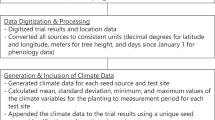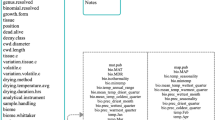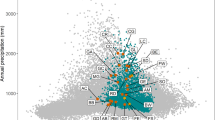Abstract
We have analyzed and described the problems and potentials of using tissue culture in micropropagation and biotechnologies related to forest improvement. Trends in forest management concepts, commerical micropropagation, and tissue culture biotechnologies are discussed. Our analysis suggests that tissue culture will contribute significantly to the improvement of forests through exploitation of existing genotypes and production of new, commercially valuable genotypes. Such changes may significantly influence worldwide management decisions in forestry.
This is a preview of subscription content, access via your institution
Access options
Subscribe to this journal
Receive 12 print issues and online access
$209.00 per year
only $17.42 per issue
Buy this article
- Purchase on Springer Link
- Instant access to full article PDF
Prices may be subject to local taxes which are calculated during checkout
Similar content being viewed by others
References
Larson, P.R. 1984. Exploring the tree as an experimental organism, p. 1–10 In: Proc. 8th North American Forest Biology Workshop., Lanner R.M.(ed.) Utah State University, Logan, UT.
Weaver, K.F. 1985. The search for our ancestors. Nat. Geographic 168: 561–623.
USOTA 1983. Wood Use. U.S. Competitiveness and Technology. Congress of the United States, Office of Technology Assessment, Washington, DC, OTA-ITE-210, 202 p.
US National Academy of Science. 1983. Report of the Briefing Panelon Agricultural Research. National Academy Press, Washington, DC,21 p.
Burg, A.W., Sacco, G.R., and Wheat, D. 1983. Biotechnology: Opportunities in the Biomedical, Chemical, Agricultural and Food Industries. Arthur D. Little Report, New York, NY. 100 p.
Nelson, N.D. and Haissig, B.E. 1984. Biotechnology in the Forest Service's North Central Forest Experiment Station, p. 139–154 In: Proc. Int. Symposium of Recent Advances in Forest Biotechnology. Michigan Biotechnology Institute, East Lansing, MI.
Skelsey, A.F. 1984. Reference Document: Needs Assessment for the Food and Agricultural Sciences. Joint Council on Food and Agricultural Sciences, Washington, DC, p. 229.
Parsons, T.J., Sinkar, V.P., Stettler, R.F., Nester, E.W. and Gordon, M.P. 1986. Transformation of poplar by Agrobacterium tumefaciens. Bio/Technology 4: 533–536.
Sederoff, R., Stomp, A.-M., Chilton, W.S. and Moore, L.W. 1986. Gene transfer into loblolly pine by Agrobacterium tumefaciens. Bio/Technology 4: 647–649.
Fillatti, J.J., Sellmer, J.C. and McCown, B.H. 1986. Regeneration and transformation of Populus tissue. HortScience 21: 773.
Fillatti, J.J., McCown, B., Sellmer, J., Haissig, B. and Comai, L. 1987. Agrobacterium mediated transformation and regeneration of poplar. J. Mol. Gen. Genet. (in press)
Sellmer, J.C., McCown, B.H. and Haissig, B.E. 1986. A selection system for increased recovery of transformed shoots regenerated from Populus leaf tissue, p. 154–155. In: Proc Sixth Int. Cong. of Plant Tissue and Cell Culture. Sommers, D. A., Gengenbach, B. G., Bies hoer, D. D., Hackett; W. P., and Green, C. E. (eds.) University of Minnesota, Minneapolis, MN.
Ettinger, T.L., Read, P.E., Hackett, W.P., Ostry, M.E. and Skilling, D.D. 1986. Development of resistance in Populus to Septoria musiva utilizing somaclonal variation, p. 83–90. In: Proc. 12th Meeting of the Canadian Tree Improvement Assoc., Part 2, 1985. Caron, F., Corn- veau, A. G., and Boyle, I.J.B. (eds.) Canadian Tree Improvement Association, Canadian Forest Service, Ottawa, Canada.
Collins, G.B. 1982. Plant cell and tissue culture: An overview, p. 230–253 In: Priorities in Biotechnology Research for International Development, Proc. of a Workshop. National Academy Press, Washington, DC.
Franclet, A., David, A., David, H., and Boulay, M. 1980. Première mise en evidence morphologique d'un rajeunissement de meristèmes primaires caulinaires de Pin maritime agé (Pinus pinaster Sol.). C.R. Acad Sci. Paris 290: 927–930.
Fouret, Y., Arnaud, Y., and Larrieu, C. 1985. Rajeunissement in vitro du Sequoia sempervirens, p. 111–137. In: 1984 Annales des recherches sylvicoles. AFOCEL, Association Foret-Cellulose, Paris.
Bouriquet, R., Tsongas, M. and Blaselle, A. 1985. Essais de rajeunissement de l'èpicèa par les cytokinins, p. 173–185. In: 1984 Annales des recherches sylvicoles. AFOCEL, Association Foret-Cellulose, Paris.
Gupta, P.K. and Durzan, D.J. 1985. Shoot multiplication from mature trees of Douglas-fir (Pseudotsuga menziesii) and sugar pine (Pinus lambertiana). Plant Cell Reports 4: 177–179
Misson, J.P. and Giot-Wirgot, P. 1985. Rajeunissement d'un clone de Thuja en vue de sa multiplication in vitro, 187–197. In: 1984 Annales des recherches sylvicoles. AFOCEL, Association Foret-Cellulose, Paris.
Williams, S.B. 1984. Protection of plant varieties and parts as intellectual property. Science 255: 18–23.
Anonymous, 1985. Product patent protection extended to plants. Biotechnology News 5: 1.
Chee, R. 1984. Micropropagation: Can nurserymen afford to ignore it? Am. Nurseryman 159: 89–103.
George, E.F. and Sherrington, P.D. 1984. Plant Propagation by Tissue Culture. Eastern Press, Reading, Berks., Great Britain, 709 p. ISBN 0-9509325-0-7.
Zobel, B. 1981. Vegetative propagation in forest management operations, p. 149–159. In: Proc. 16th Southern Forest Tree Improvement Conf., Blacksburg, V A. Virginia Polytechnical and State University, Blacksburg, VA.
Aitken-Christie, J. 1984. Micropropagation of Pinus radiata. The Plant Propagator 30: 9–11.
Anonymous, 1985. 1984 Marcus Wallenbeng Prize awarded to Aracruz forestry team. Aracruz Newsletter, March, 1985.
Kleinschmit, J. and Schmidt, J. 1977. Experiences with Picea abies cuttings propagation in Germany and problems connected with large scale application. Silvae Genetica 26: 5–6.
Dietrichson, J. and Kierulf, C. 1982. Selection of eight-year-old Norway spruce (Picea abies (L.) Karst.) plants in a progeny trial and mass production by cuttings. Meddelelser fra Norsk Institutt for Skogforskning (Reports of the Norwegian Forest Research Institute), 28 p.
Thompson, D.G. 1984. Clonal reforestation: Forests of the future?, p. 3–28. In: Seedling Physiology and Reforestation Success. Duryea, M. L. and Brown, G. N. (eds.) Martinus Nijhoff/Dr. W. Junk Publishens, Dordrecht, Boston, London.
Struve, D.K., Talbert, J.T. and McKeand, S.E. 1984. Growth of rooted cuttings and seedlings in a 40-year-old plantation of eastern white pine. Can. J. For. Res. 14: 462–464.
Gleed, J.A. 1983. Tree improvement—first results from a radiata pine production forest. Appita 36: 386–390.
Huhtinen, O. and Yahyaoglu, Z. 1974. Das Frühe Blühen von aus Kalluskulturen herangezogenen Pflänzchen bei den Birke (Betula pendula Roth.). Silvae Genetica 23: 32–34.
Boulay, M. 1977. Multiplication rapide du Sequoia Sempervirens en culture in vitro, p. 37–67. In: 1976 Annales des Recherches Sylvicoles, AFOCEL, Association ForetCellulose, Paris.
Barker, P.K., de Fossard, R.A., and Bourne, R.A. 1977. Progress toward clonal propagation of Eucalyptus species by tissue culture techniques. Proc. Int. Plant Prop. Soc. 27: 546–556.
de Fossard, R.A., Barker, P.K., and Bourne, R.A. 1977. The organ culture of nodes of four species of eucalyptus. Acta Hort. 78: 157–165.
Gupta, P.K., Mascarenhas, A.F. and Jagannathan, V. 1981. Tissue culture of forest trees—Clonal propagation of mature trees of Eucalyptus citriodora Hook, by tissue culture. Plant Sci. Lett. 20: 195–201
Bennett, I.J. and McComb, J.A. 1982. Propagation of jarrah (Eucalyptus marginata) by organ and tissue culture. Aust. For. Res. 12: 121–127.
Franclet, A. and Boulay, M. 1982. Micropropagation of frost resistant eucalypt clones. Aust. For. Res. 13: 83–89.
Reilly, K. and Washer, J. 1977. Vegetative propagation of radiata pine by tissue culture: plantlet formation from embryonic tissue. New Zealand J. For. Sci. 7: 199–206.
Aitken, J., Horgan, K.J. and Thorpe, T.A. 1981. Influence of explant selection on the shoot-forming capacity of juvenile tissues of Pinus radiata. Can. J. For. Res. 11: 112–117.
Horgan, K.J. and Aitken, J. 1981. Reliable plantlet formation from embryos and seedling shoot tips of radiata pine. Physiol. Plant. 53: 170–175.
Kellison, R.C. and Gingrich, S. 1984. Loblolly pine management and utilization—state of the art. Southern J. Applied For. 8: 88–96.
USDA. 1985. 1984 U.S. Forest Planting Report. USDA-Forest Service, Washington, DC, 12 p.
Bapat, V.A. and Rao, P.S. 1979. Somatic embryogenesis and plantlet formation in tissue cultures of sandalwood (Santalum album L.). Ann. Bot. 44: 629–630
Sita, G.L., Vaidyanathan, C.S., and Ramakrishnan, T. 1982. Applied aspects of plant tissue culture with special reference to tree improvement. Curr. Sci. 51: 88–92.
El-Nil, A. 1980. Embryogenesis of Gymnosperm Forest Trees. United States Patent No. 4,217,730.
Gharyal, P.K. and Maheshwari, S.C. 1981. In vitro differentiation of somatic embryoids in a leguminous tree—Albizzia lebbeck L. Naturwissenschaften 68: 379–380.
Sommer, H.E. and Brown, C.L. 1980. Embryogenesis in tissue cultures of sweetgum. For. Sci. 26: 257–260.
Hakman, I.C. and von Arnold, S. 1985. Plantlet regeneration through somatic embryogenesis in Picea abies (Norway spruce). J. Plant. Physiol. 121: 149–158.
Hakman, I.C., Fowke, L.C., von Arnold, S. and Erikosson, T. 1985. The development of somatic embryos in tissue cultures initiated from immature embryos of Picea abies (Norway spruce). Plant Sci. Lett. 38: 53–59.
Gupta, P.K. and Durzan, D.J. 1986. Somatic polyembryogenesis from callus of mature sugar pine embryos. Bio/Technology 4: 643–645.
Ozias-Akins, P., Rao, P.S., and Schieder, O. 1985. Plant regeneration from embryonic suspension-derived protoplasts of sandalwood (Santalum album), p. 338–339. In: Tissue Culture in Forestry and Agriculture. Henke, R. R., Hughes, K. W., Constantin, M. J., and Hollaender, A. (eds.) Plenum Press, NY.
Sticklen, M.B., Lineberger, R.D. and Dormir, S.C. 1985. Isolation and culture of ‘Pioneer’ elm protoplasts, p. 19 In: Biotechnology in Plant Science: Relevance to Agriculture in the Eighties, Cornell University Biotechnology Program, Ithaca, NY.
Sticklen, M.B., Lineberger, R.D. and Dormir, S.C. 1985. Isolation and culture of Ulmus × ‘Homestead’. Plant Sci. 41: 117–120.
Russell, J.A. and McCown, B.H. 1986. Culture and regeneration of Populus leaf protoplasts isolated from non-seedling tissue. Plant Sci. (in press).
Durzan, D.J. and Lopushanski, S.M. 1975. Propagation of American elm via cell suspension cultures. Can. J. For. Res. 5: 273–277.
Teasdale, R.D. and Rugini, E. 1983. Preparation of viable protoplasts from cell suspension-cultured loblolly pine (Pinus taeda) cells and subsequent regeneration to callus. Plant Cell Tissue Organ Culture 2: 253–261.
Hakman, I.C. and von Arnold, S. 1983. Isolation and growth of protoplasts from cell suspensions of Pinus contorta Dougl. ex Loud. Plant Cell Reports 2: 92–94.
Smith, M.A.L. and McCown, B. 1982/1983. A comparison of source tissue for protoplast isolation from three woody plant species. Plant Sci. Lett. 28: 149–156.
Ahuja, M.R., 1982. Isolation, culture, and fusion of protoplasts: problems and prospects. Silvae Genetica 31: 2–3.
Ahuja, M.R., 1983. Short Note: Isolation and culture of mega and normal protoplasts in aspen. Silvae Genetica 32: 5–6.
Kirby, E.G. 1980. Factors affecting proliferation of protoplasts and cell cultures of Douglas-fir, p. 289–293. In: Plant Cell Cultures: Results and Perspectives. Sala, S., Baisi, B., Cella, R. and Cifenni, O. (eds.) Elsevier/North Holland.
Kirby, E.G. and Cheng, T.-Y. 1979. Colony formation from protoplasts derived from Douglas fir cotyledons. Plant Sci. Lett. 14: 145–154.
David, A. and David, H. 1979. Isolation and callus formation from cotyledon pnotoplasts of pine (Pinus pinaster). Zeit. Pflanzenphysiol. 94: 173–177.
David, H., David, A. and Mateille, T. 1982. Evaluation of parameters affecting the yield, viability and cell division of Pinus pinaster protoplasts. Physiol. Plant. 56: 108–113.
David, H., Jarlet, E. and David, A. 1984. Effects of nitrogen source, calcium concentration and osmotic stress on protoplasts and protoplast-derived cell cultures of Pinus pinaster cotyledons. Physiol. Plant. 61: 477–482.
David, H., de Boucaud, M.-T. and Gaultier, J.-M., and David, A. 1986. Sustained division of protoplast-derived cells from primary leaves of Pinus pinaster, factors affecting growth and change in nuclear DNA content. Tree Physiol. 1: 21–30.
Faye, M. and David, A. 1983. Isolation and culture of gymnosperm root protoplasts (Pinus pinaster). Physiol. Plant. 59: 359–362.
Lester, D.T. and Berbee, J.G. 1977. Within-clone variation among black poplar trees derived from callus culture. For. Sci. 23: 122–131.
Diner, A.M. and Mott, R.L. 1982. A rapid axenic assay for hypersensitive resistance of Pinus lambertiana to Cronartium ribicola. Phytopathology 72: 864–865.
Diner, A.M. and Mott, R.L. 1982. Axenic cultures from basidiospores of Cronartium ribicola. Can. J. Bot. 60: 1950–1955.
Jacobi, W.R. 1982. Growth medium for dual cultures of loblolly pine callus and Cronartium fusiforme. Phytopathology 72: 136–138.
Frampton, L.J., Amerson, H.V. and Weir, R.J. 1981. Potential of in vitro screening of loblolly pine for fusiform rust resistance, p. 325–331 In: Proc. 16th Southern Forest Tree Improvement Conf., Blacksburg, VA. Virginia Polytechnical and State University, Blacksburg, VA.
Diner, A.M., Mott, R.L. and Amerson, H.V. 1984. Cultured cells of white pine show genetic resistance to axenic blister rust hyphae. Science 224: 407–408.
Mott, R.L., Thomas, H.A. and Namkoong, G. 1978. In vitro rearing of southern pine beetle larvae on tissue-cultured loblolly pine callus. Ann. Entomolog. Soc. Amer. 71: 564–566.
Burkot, T.R. and Benjamin, D.M. 1980. The bionomics of the cottonwood leaf beetle, Chrysomela scripta Fab, on tissue cultured Aigeiros (Populus × euramericana (Dode) Guinier subclones. Rev. Applied Entomol. 68: 12.
Kartha, K.K. (ed.) 1985. Cryopreservation of Plant Cells and Organs. CRC Press, Inc.
Jelaska, S. and Bornman, C.H. 1986. Application of cell culture methods in forestry. In: Proc. 18th Cong. of the Int. Union of For. Res. Organizations. International Union of Forestry Research Organizations, Zagreb, Yugoslavia (in press).
Farnum, P., Timmis, R. and Kulp, J.L. 1983. Biotechnology of forest yield. Science 219: 694–702.
Talbert, J.T., Weir, R.J., and Arnold, R.D. 1985. Costs and benefits of a mature first-generation loblolly pine tree improvement program. J. For. 83: 162–166.
USDA. 1985. The Friday Newsletter. USDA-Forest Service, Office of Information, Washington, DC, No. 52, 4 p.
Guenther, R. 1986. Real estate, p. 33. In: The Wall Street J. Feb. 19, Section II.
Crowell, J.B.,Jr. 1984. Can timber growing investments be profitable? J. For. 82: 536–538.
Dutrow, G.F. and Kaiser, H.F. 1984. Economic opportunities for investments in forest management in the southern United States. Southern J. Applied For. 8: 76–79.
Kester, D.E. 1983. The clone in horticulture. HortScience 18: 831–837.
Larkin, P.J. and Scowcroft, W.R. 1981. Somaclonal variation—a novel source of variability from cell cultures for plant improvement. Theor. Appl. Genet. 60: 197–214.
Evans, D.A. and Sharp, W.R. 1986. Applications of somaclonal variation. Bio/Technology 4: 528–532.
Nelson, N.D., Haissig, B.E. and Riemenschneider, D.E. 1984. Applying the new somaclonal technology to forestry, p. 27–34. In: Proc. TAPPI Research and Development Conference. TAPPI Press, Atlanta, GA.
Nelson, N.D., Haissig, B.E. and Riemenschneider, D.E. 1987. Applying the new somaclonal technology to fiber supply in the pulp and paper industry. BioProcess Engineering (in press).
Nelson, N.D., 1985. North Central Forest Experiment Station biotechnology program—Application to tree improvement, p. 14–22. In: Proc. 18th Southern Forest Tree Improvement Conf., Long Beach, MS. University of Southern Mississippi, Gulf Park, MS.
Nelson, N.D. and Haissig, B.E. 1986. Herbicide stress: Use of biotechnology to confer herbicide resistance to selected woody plants, p. 191–215. In: Stress Physiology and Forest Productivity. Hennessey, T. C., Dougherty, P. M., Kossuth, S. V. and Johnson, J. D. (eds.), Martinus Nijhoff Pub., Dordrecht, Boston, Lancaster.
Wolter, K.E. 1968. Root and shoot initiation in aspen callus cultures. Nature 219: 509–510.
Cheng, T.-Y. and Voqui, T.H. 1977. Regeneration of Douglas-fir plantlets through tissue culture. Science 198: 306–307.
Winton, L.L. and Verhagen, S.A. 1977. Shoots from Douglas-fir cultures. Can. J. Bot. 55: 1246–1250.
Minocha, S.C. 1980. Callus and adventitious shoot formation in excised embryos of white pine. Can. J. Bot. 58: 366–370.
Herrera, H.G., Wagely, L.M. and Phillips, G.C. 1986. De novo plantlet regeneration from long-term callus cultures of Pinus eldarica, p. 266 In: Proc. 6th Int. Cong. Plant Tissue and Cell Culture. Sommers, D. A., Gengenbach, B. G., Biesboer, D. D., Hackett, W. P., and Green, C. E. (eds.) University of Minnesota, Minneapolis, MN (Abst.).
USDA 1983. 1982 U.S. Forest Planting Report. USDA-Forest Service, Washington, DC, 15 p.
Author information
Authors and Affiliations
Rights and permissions
About this article
Cite this article
Haissig, B., Nelson, N. & Kidd, G. Trends in the Use of Tissue Culture in Forest Improvement. Nat Biotechnol 5, 52–59 (1987). https://doi.org/10.1038/nbt0187-52
Issue Date:
DOI: https://doi.org/10.1038/nbt0187-52
This article is cited by
-
Establishment and in vitro morphogenesis of sapucaia explants (Lecythidaceae)
In Vitro Cellular & Developmental Biology - Plant (2020)
-
Regeneration of plants through somatic embryogenesis in Thymus hyemalis Lange, a potential medicinal and aromatic plant
In Vitro Cellular & Developmental Biology - Plant (2014)
-
Micropropagation of Capparis decidua (Forsk.) Edgew. — a tree of arid horticulture
Plant Cell Reports (1995)



